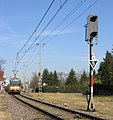M table
An M board (Signal Zs 12 ) is an additional signal used in Germany that can be attached to the mast of a main signal .
The M-board allows the driver to drive past a main signal indicating a stop or a disturbed main signal after a verbal or telephone request by the dispatcher , without a written command having to be issued or a substitute signal being used. A train journey approved in this way is a train journey with a special order . The M board is white with a red border and a red M in cursive.
The M-Tafel was introduced by the Deutsche Reichsbahn on January 1st, 1931 . The signal was initially only valid for the electric and steam-powered trains of the Berlin S-Bahn and was only attached to main signals that did not have an ad signal (from 1935: replacement signal ). In 1935 the signal was added to the signal book . It was only used on routes with a close train sequence by order of the respective railway management . The request was given orally by the responsible dispatcher or supervisory officer . In 1959, the Deutsche Reichsbahn included the M panel as signal Zs 2 in the group of additional signals . From 1971 the placing of the order by telephone was valid. In spite of the signal meaning "At the stop showing the main signal on verbal or telephone instruction drive past", the signal was also valid when the signal was extinguished or doubtful. The restriction of use on routes with a close train sequence has been lifted. At the Deutsche Bundesbahn , from 1959, the M-panel was initially on a par with the mast signs ; the commissioning continued to be verbal. It was not until later that the order was transmitted by telephone and the M board as signal Zs 12 became an independent signal. Since the merging of the signal books of both railways, the West German signal Zs 12 has been used nationwide.
M board on a Ks signal on the Hamburg S-Bahn
M board on the Hardtbahn
Web links
Individual evidence
- ↑ DB Netz AG (Ed.): Guideline 301 - Signalbuch . Module 301.0301 section December 12th, 2009.
- ↑ Bernd Kuhlmann: Signal connections. The signal system of the light rail from 1928 . In: Electricity instead of steam! GVE, Berlin 1999, ISBN 3-89218-275-2 , pp. 52-61 .
- ^ Signal book (SB) DV 301 of the Deutsche Reichsbahn-Gesellschaft . Section B. Signals. I main and distant signals. April 23, 1935 ( bahnstatistik.de [PDF]).
- ↑ Overview of the essential changes to the 1971 edition of the Signalbuch compared to the 1958 edition . Section 2.4 Changes to Section 3. On § 8 paragraphs 1 and 3 . 13 .
- ↑ Overview of the essential changes to the 1971 edition of the Signalbuch compared to the 1958 edition . Section 2.4 Changes to Section 3. On Section 8 (4) p. 13 .
- ^ The signals of the Deutsche Bundesbahn . Mast signs and special characters. December 15, 1959 ( bahnstatistik.de [PDF]).
- ↑ Eisenbahn-Bundesamt (Ed.): Eisenbahn-Signalordnung (ESO) with instructions for carrying out the ESO and signals with temporary validity . September 18, 2015, p. 143 ( bund.de [PDF; accessed on March 11, 2018]).




